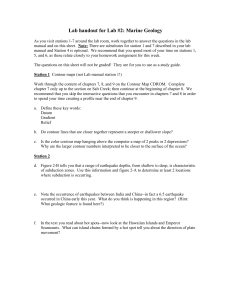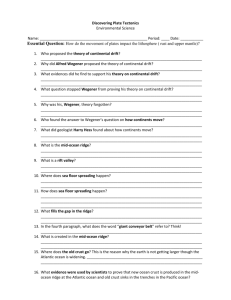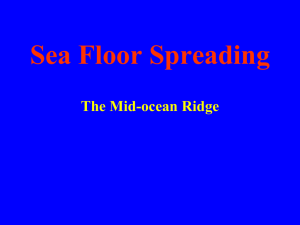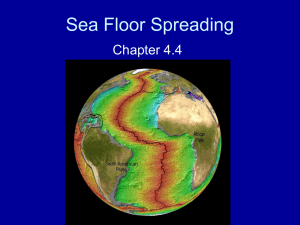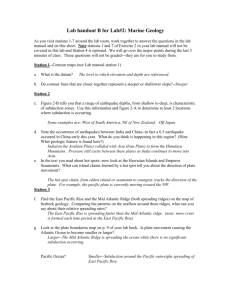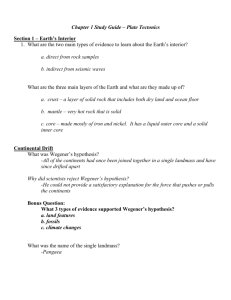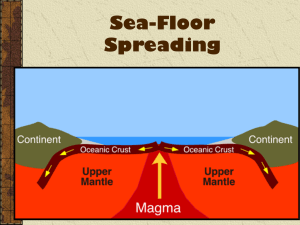Word
advertisement
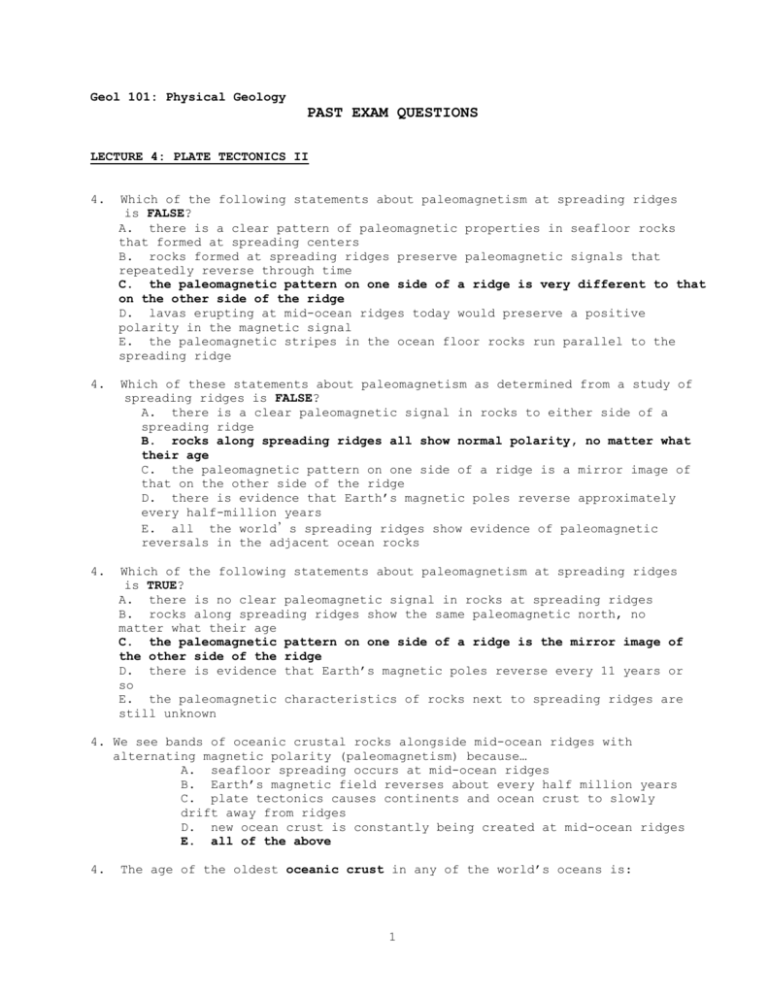
Geol 101: Physical Geology PAST EXAM QUESTIONS LECTURE 4: PLATE TECTONICS II 4. Which of the following statements about paleomagnetism at spreading ridges is FALSE? A. there is a clear pattern of paleomagnetic properties in seafloor rocks that formed at spreading centers B. rocks formed at spreading ridges preserve paleomagnetic signals that repeatedly reverse through time C. the paleomagnetic pattern on one side of a ridge is very different to that on the other side of the ridge D. lavas erupting at mid-ocean ridges today would preserve a positive polarity in the magnetic signal E. the paleomagnetic stripes in the ocean floor rocks run parallel to the spreading ridge 4. Which of these statements about paleomagnetism as determined from a study of spreading ridges is FALSE? A. there is a clear paleomagnetic signal in rocks to either side of a spreading ridge B. rocks along spreading ridges all show normal polarity, no matter what their age C. the paleomagnetic pattern on one side of a ridge is a mirror image of that on the other side of the ridge D. there is evidence that Earth’s magnetic poles reverse approximately every half-million years E. all the world’s spreading ridges show evidence of paleomagnetic reversals in the adjacent ocean rocks 4. Which of the following statements about paleomagnetism at spreading ridges is TRUE? A. there is no clear paleomagnetic signal in rocks at spreading ridges B. rocks along spreading ridges show the same paleomagnetic north, no matter what their age C. the paleomagnetic pattern on one side of a ridge is the mirror image of the other side of the ridge D. there is evidence that Earth’s magnetic poles reverse every 11 years or so E. the paleomagnetic characteristics of rocks next to spreading ridges are still unknown 4. We see bands of oceanic crustal rocks alongside mid-ocean ridges with alternating magnetic polarity (paleomagnetism) because… A. seafloor spreading occurs at mid-ocean ridges B. Earth’s magnetic field reverses about every half million years C. plate tectonics causes continents and ocean crust to slowly drift away from ridges D. new ocean crust is constantly being created at mid-ocean ridges E. all of the above 4. The age of the oldest oceanic crust in any of the world’s oceans is: 1 A. B. C. D. E. 4600 million years 1200 million years 500 million years 180 million years 70 million years 4. The mid-Atlantic ridge is an example of a spreading ridge. As a result of the process of (1) _________ that occurs at this ridge, the youngest oceanic crust in the north Atlantic must be located (2) ____________: A. (1) seafloor spreading (2) along the ridge itself B. (1) seafloor spreading (2) along the coasts of N. America and Europe C. (1) seafloor spreading (2) with a striped pattern of repeating old and young rocks D. (1) subduction (2) along the ridge itself E. (1) subduction (2) along the coasts of N. America and Europe 4. The mid-Atlantic ridge is an example of a spreading ridge. As a result of the process of (1) _________ that occurs at this ridge, the oldest oceanic crust in the north Atlantic must be located (2) ____________: A. (1) seafloor spreading (2) along the ridge itself B. (1) seafloor spreading (2) along the coasts of N. America and Europe C. (1) seafloor spreading (2) with a striped pattern of repeating old and young rocks D. (1) subduction (2) along the ridge itself E. (1) subduction (2) along the coasts of N. America and Europe 4. As a result of seafloor spreading at a mid-ocean ridge, the following is true: A. rocks on one side of the ridge have the opposite magnetic polarity to the other side B. Earth’s magnetic field reverses about every half million years C. older oceanic crust is slowly pushed away from ridge D. continents plow through the oceanic crust E. all of the above 4. The oldest oceanic crust occurs (1) ________ and the youngest occurs (2) __________. A. (1) at mid-ocean ridges (2) along subduction zones B. (1) at mid-ocean ridges (2) along the continental margins C. (1) along the continental margins (2) at mid-ocean ridges D. (1) along the continental margins (2) along subduction zones E. (1) somewhere beneath the continental slope (2) at midocean ridges 4. As a result of seafloor spreading: A. new ocean crust is generated at ridges to accommodate the spreading plates 2 B. continents attached to the plates on each side of the ridge slowly move apart C. the age of ocean crust increases with increasing distance away from the ridge D. a record of paleomagnetic reversals is recorded in rocks that formed at the ridge E. all of the above 4. If you were to collect samples at the following locations along the sea floor of the North Atlantic ocean, which sample of rock would be the oldest? A. along the spreading ridge B. where the spreading ridge comes ashore in Iceland C. just east of the spreading ridge D. just west of the spreading ridge E. just off the coast of North America 4. Tectonic plates are not very thick compared to the radius of the Earth because they are only made up of rocks that are part of the: A. ocean crust B. continental crust C. lithosphere D. asthenosphere E. mantle 4. Tectonic plates _________. A. (1) B. (1) C. (1) D. (1) E. (1) are made up of (1) ______ that floats on the underlying (2) basalt (2) gabbro lithosphere (2) asthenosphere continental crust (2) mantle continental and oceanic crust (2) lithosphere lithosphere (2) outer core 4. The fastest plate motion velocity that has been measured anywhere on Earth is 18 cm/yr, which occurs at the: A. San Andreas fault B. mid-Atlantic ridge C. East Pacific Rise D. Juan de Fuca spreading ridge E. Aleutian subduction zone 4. The fastest A. B. C. D. E. 4. What type of plate boundary is represented by a mid-ocean spreading ridge? A. divergent B. convergent C. transform D. subduction E. strike-slip 4. The three types of tectonic plate boundaries are: moving mid-ocean ridge spreading center is: the mid-Atlantic ridge the East Pacific Rise the Juan de Fuca ridge the Cascadia subduction zone the Himalayas 3 A. B. C. D. E. normal, reverse, and strike-slip active, passive, and extinct divergent, convergent, and transform seismic, volcanic, and subducting ocean-ocean, ocean-continent, and continent-continent 4. Which of the following combinations is a correct match between (1) a type of plate boundary; and (2) a geographic example of that type of plate boundary? A. (1) divergent (2) San Andreas fault B. (1) convergent (2) Red Sea C. (1) transform (2) Japan D. (1) transform (2) Himalayas E. (1) divergent (2) East African Rift Valley 4. Which of the following combinations is a correct match between (1) a type of plate boundary; and (2) a characteristic feature of that type of plate boundary? A. (1) divergent (2) subduction zone B. (1) convergent (2) transform fault C. (1) transform (2) subduction zone D. (1) transform (2) island arc E. (1) divergent (2) rift valley 4. Which of the following features would be expected to be found in a divergent tectonic setting? A. rift valley B. subduction zone C. overriding plate D. back-arc basin E. volcanic arc 4. Ocean basins and mid-ocean ridges are first created when the interior of a continent splits apart and basalt lava starts erupting within the ___________ that forms on the continent. A. horst B. rift valley C. normal fault D. East African rift E. subduction zone 4. An example of where a new ocean basin is trying to form is: A. the East Africa Rift Valley B. the mid-Atlantic ridge C. Iceland D. the Eastern Snake River Plain E. the Himalayas 4. Which of the following locations would be expected to exhibit normal faults? A. the East African Rift Valley B. the mid-Atlantic ridge C. divergent plate boundaries D. all of the above E. none of the above 4. The three types of convergent plate boundaries are: 4 A. B. C. D. E. normal, reverse, and strike-slip active, passive, and extinct divergent, convergent, and transform seismic, volcanic, and subducting ocean-ocean, ocean-continent, and continent-continent 4. Which of the following statements about convergent plate boundaries is TRUE? A. when two plates collide, at least one of the plates will always subduct B. the collision of oceanic crust against continental crust will result in subduction of the continent C. there are only two types of convergent boundaries: ocean-ocean and ocean-continent D. if two ocean plates collide, melting along the subduction zone creates an island arc of volcanoes E. it takes two continents colliding in order to form a volcanic arc mountain range 4. Which of the following statements about convergent plate boundaries is TRUE? A. when two continents collide, at least one of the plates will always subduct B. the collision of oceanic crust against continental crust will result in subduction of the continent C. there are only two types of convergent boundaries: ocean-ocean and ocean-continent D. where two ocean plates collide, magma rises through the overriding plate to form a back-arc basin E. when two continents collide, a suture zone and a mountain range form at the collision zone 4. An island arc is a chain of volcanoes associated with (1) ______. An example is (2) _______. A. (1) ocean-continent plate boundaries (2) the Phillipines B. (1) ocean-continent plate boundaries (2) the Cascades C. (1) ocean-ocean plate boundaries (2) the Cascades D. (1) ocean-ocean plate boundaries (2) Japan E. (1) hotspots (2) Hawaii 4. An example of a volcanic arc along an ocean-continent plate boundary: A. Himalayas B. Cascades C. Aleutian Islands D. Japan E. Phillipines 4. What type of plate boundary may be associated with a suture zone? A. ocean-ocean boundary B. ocean-continent boundary C. continent-continent boundary D. transform boundary E. all plate boundaries have suture zones 4. The top of Mt. Everest exhibits (1) __________ which indicates that (2) ___________. 5 A. (1) a suture zone (2) it must be an oceancontinent plate boundary B. (1) a crater (2) it must be a volcano C. (1) constant elevation (2) the collision between India and Asia is now complete D. (1) glacial features (2) it used to be near the south pole as part of Gondwana E. (1) sea shell fossils (2) it is made of old ocean floor that got uplifted during collision 4. At convergent plate boundaries, the volcanic mountain chains that form are called (1) ________ in an ocean-ocean setting and (2) __________ in an ocean-continent setting. A. (1) island arcs (2) island chains B. (1) island arcs (2) volcanic chains C. (1) island arcs (2) volcanic arcs D. (1) volcanic arcs (2) island chains E. (1) volcanic arcs (2) island arcs 4. At an ocean-continent convergent margin, the (1) ________ plate always subducts beneath the (2) __________ plate because (3) ______________________. A. (1) overriding (2) underriding (3) it is less dense B. (1) continental (2) oceanic (3) it is thicker C. (1) oceanic (2) overriding (3) it is more easily deformed D. (1) continental (2) overriding (3) it melts more easily, forming volcanoes E. (1) oceanic (2) continental (3) it is denser 4. The San Andreas fault is an example of the following type of tectonic plate boundary: A. divergent B. convergent: continent-continent C. convergent: ocean-continent D. convergent: ocean-ocean E. transform 4. An example of a transform fault that comes on-land: A. Cascadia subduction zone B. San Andreas fault C. mid-Atlantic ridge D. Gulf of California E. transform faults cannot come on-land 4. The main driving force behind plate tectonics is (1) __________ in the mantle. Sometimes, a large plume of hot magma rises all the way to the surface, creating a (2) ___________. A. (1) convection (2) hot spot B. (1) melting (2) volcano C. (1) cooling (2) lava lamp D. (1) jets (2) Plinian column E. (1) subduction (2) chain of volcanic islands 6 4. The Hawaiian Islands are an example of volcanoes that did not form along a tectonic plate boundary. Instead, they formed in the middle of the Pacific plate directly above a: A. convection cell B. mantle plume C. subduction zone D. mid-ocean ridge E. lava lamp 7

